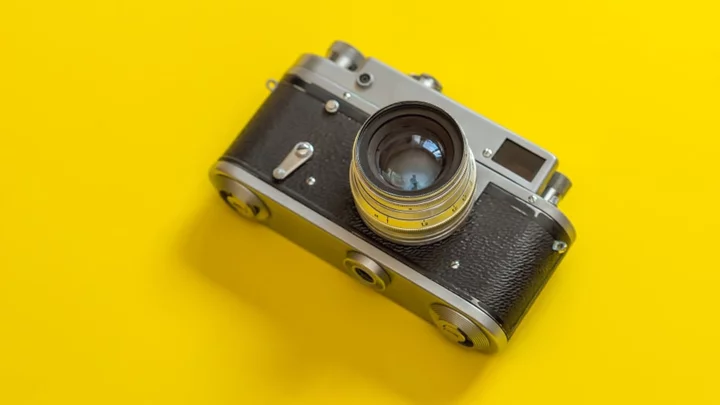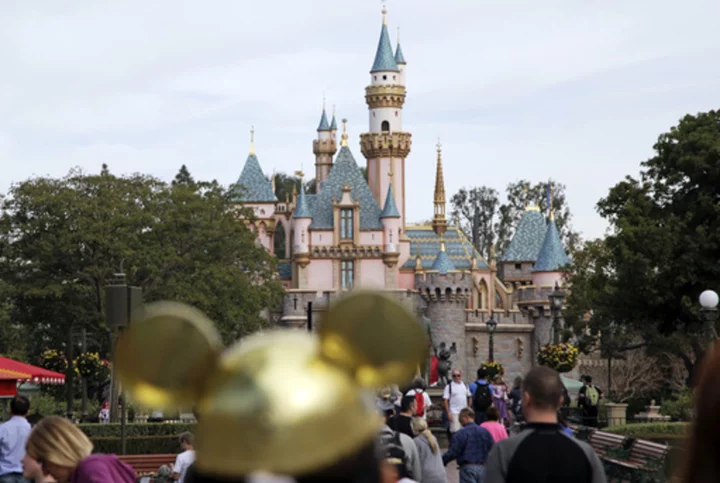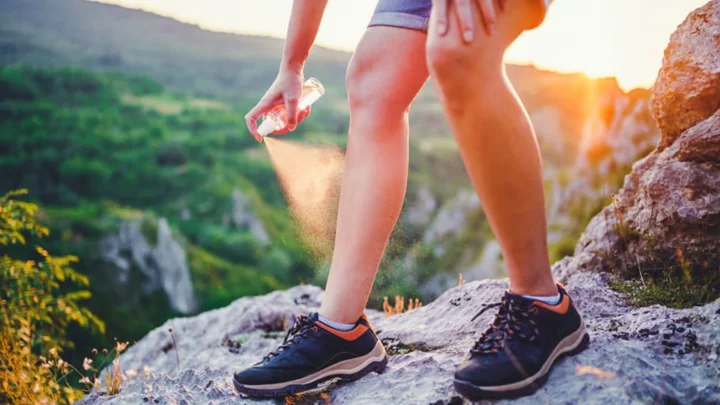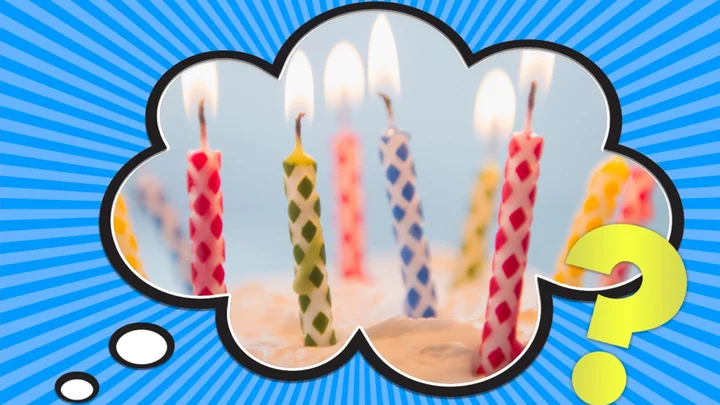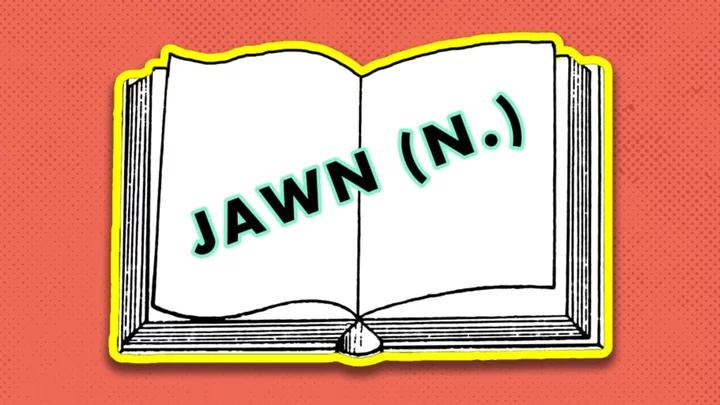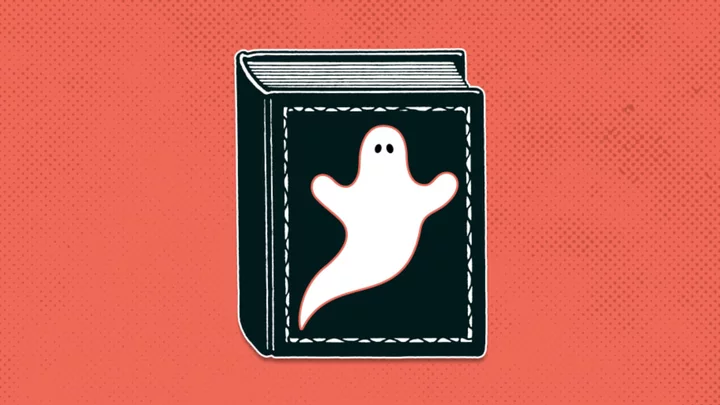A picture’s worth a thousand words—but sometimes, you also want the words. Discover the who, when, where, why, and how behind some of history’s most iconic photos—from Elvis Presley wearing a velvet suit to meet Richard Nixon to the migrant mother who unwittingly became the face of the Great Depression—below, in a list adapted from an episode of The List Show on YouTube.
1. Einstein’s Iconic Tongue-Out Photo
Picture Albert Einstein. Now, is his tongue sticking out?
If it is, your mental portrait is probably based on a photo captured by Arthur Sasse. It was March 14, 1951, and Einstein was leaving his 72nd birthday party at the Institute for Advanced Study in Princeton, New Jersey. Paparazzi swarmed as the famed physicist got into a car with Dr. Frank Aydelotte, the institute’s former director, and Aydelotte’s wife, Marie Jeanette.
After reportedly shouting something like “Enough is enough!” or “That’s enough!” (depending on the account), the birthday boy stuck his tongue out at the persistent press. Sasse snapped the shot. However exasperated Einstein felt in the moment didn’t last: He actually procured a number of copies of the photo to send to friends.
The image has been recreated on everything from brick walls to corn fields, perpetuating the public impression of Einstein as a bit of a goofball. (The messy hair probably helped, too.)
2. Elvis Meets Nixon
A celebrity meeting the president isn’t strange, but the story behind a famous photo of Elvis Presley and President Richard Nixon is.
By 1970, it’s fair to say that things were getting odd for the King of Rock and Roll. After he became aware of death threats that the FBI deemed credible, he began taking the stage with multiple firearms on his person.
He had also spent more than $100,000 on Christmas gifts that year, purchasing 10 cars and 32 handguns (for the record, that’s about three-quarters of a million dollars in today’s money—less of a blue Christmas than a green one).
On an impromptu trip to the nation’s capital, Presley arranged a meeting with Nixon. And by “arranged,” we mean he showed up at the White House uninvited and asked to meet the president. At this time, he already had a collection of police badges but, according to Smithsonian Magazine, “decided that what he really wanted was a badge from the federal Bureau of Narcotics and Dangerous Drugs.”
The badge wouldn’t have conferred any special powers on Presley, but as his wife Priscilla put it in her autobiography, “The narc badge represented some kind of ultimate power to him.” With it, she wrote, “he [believed he] could legally enter any country both wearing guns and carrying any drugs he wished.”
Nixon, for his part, was probably eager to associate with such a beloved pop culture figure. Even if he wasn’t at his peak, per se, Elvis was enjoying a career resurgence, and the President seemed to think the musician could help him reach young people in his battle against countercultural forces embodied by the hippy movement.
Elvis wore a purple velvet suit to the meeting and brought along a gun to give the Commander-in-Chief. Towards the end of the meeting, the President did instruct an advisor, “Bud” Krogh, to get Elvis the badge he so ardently (and bafflingly) wanted. But, of course, it was an honorary badge. As Secret Service agent Clint Hill later noted, “[Elvis] believed he had some authority, which he did not have … [But] he went away happy.”
Nixon later sent Elvis a letter thanking him for the gun, which he called an “impressive gift.” You can read the full letter above.
3. The Blue Marble
The most famous photo of the entire Earth features swirling clouds over the south polar ice cap and a breathtaking view of Africa. The reason it’s called “The Blue Marble” is hardly a mystery. But the photographer’s identity is.
Here’s what we know: The snapshot was taken on December 7, 1972, roughly five hours after the Apollo 17 mission launched from NASA’s Kennedy Space Center in Florida. The Saturn V rocket was some 28,000 miles from Earth at the time.
The Blue Marble was part of a series of photos captured over a several-minute period when the three astronauts aboard were taking turns with a Hasselblad Camera. Though there is an audio recording of their exchange, it doesn’t shed light on who snapped the prize shot.
And the men—Commander Eugene Cernan, Harrison “Jack” Schmitt, and Ronald Evans—aren’t telling. Or rather, their accounts contradicted each other: All three claimed credit for the photo.
Former NASA archivist Mike Gentry has a theory as to why. As he told Outside magazine in 2017, “I think the crew got together and said, ‘Let’s don’t really tell them, and when they ask, you just say you took it.”
That, or they all just really wanted the credit, which is pretty relatable.
4. The Horse in Motion Series
When Eadweard Muybridge took a bunch of photos of a horse in the late 1870s, he wasn’t trying to invent cinema. He was trying to see if all four of a galloping horse’s hooves were ever in the air together. The task had been put to him earlier that decade by Leland Stanford, a railroad tycoon and racehorse enthusiast who would later found Stanford University.
It took a while for Muybridge, a professional photographer, to really get the project off the ground. This was partly because he had to take a hiatus to stand trial for murdering his wife’s lover, which he 100-percent did do. The jury acquitted him on the grounds of “justifiable homicide.”
Muybridge was also delayed because he pretty much had to invent the technology needed to capture images in such quick succession. Cameras of the era typically required two seconds of exposure time. So Muybridge rigged a system of trip wires connected to special mechanical shutters that would each snap a photo in about one one-thousandth of a second as the horse sped down the path.
Muybridge’s various experiments at Stanford’s horse farm in Palo Alto, California, generated several series of photos, all titled The Horse in Motion. As projectors didn’t yet exist, the photo series weren’t “movies” per se. But the project did prompt Muybridge to develop a device that helped inspire the invention of projectors: the zoopraxiscope. It was basically a glass disc, with illustrations similar to the Horse in Motion photos decorating the rim. According to one contemporary description, the images were “projected on to a screen by an optical lantern, the result being that one finds it hard to believe one is not actually looking at the moving original.”
As for who the jockeys were, it’s often frustratingly unclear. Historian Phillip Prodger told the Daily Beast that “At least one of the jockeys in the Horse in Motion series (the Sallie Gardner running picture) appears to have been African American and probably was (many of the best jockeys of the day were African American) but it’s really hard to prove, because we know next to nothing about any of the jockeys, and because … all the faces in the earliest pictures are in silhouette.”
The footage of a Black jockey on a horse featured in Jordan Peele’s NOPE is from a project Muybridge completed in the late 1880s. Despite the film’s poetic invention, his name is also lost to history.
5. Princess Diana Cuts a Rug With John Travolta
In 1985, Nancy Reagan played fairy godmother to grant Princess Diana one wish: dancing with Danny Zuko.
The 24-year-old princess was on her first trip to the U.S. with her then-husband Prince Charles in tow. On November 9, President Ronald Reagan hosted a star-studded dinner for the royal couple at the White House. The Washington Post reported at the time that three of the guests had been invited specifically at Diana’s behest: Clint Eastwood, Neil Diamond, and John Travolta.
The star of Grease recalled how the action unfolded in an interview for the PBS program In Their Own Words: Princess Diana: “About 10 o’clock at night, Nancy Reagan tapped on my shoulder and said, ‘The princess, her fantasy is to dance with you. Would you dance with her tonight?’ And I said, ‘Well, of course.’”
Nancy Reagan said she’d introduce the two around midnight, which she did, and Travolta, heart racing, asked Diana for a dance. Then, he remembered, “the whole room cleared. We danced for what felt like 15 minutes.”
According to White House photographer Pete Souza, who captured the moment on camera, the pair cut a rug to a medley of songs from Saturday Night Fever, played by the military band. Souza said the princess also hit the dance floor with her other two guests of choice, Clint Eastwood and Neil Diamond, as well as Tom Selleck and the president. What a dance card.
6. John Carlos and Tommie Smith’s Black Power Salute
The medal ceremony for the 200-meter dash at the 1968 Olympics in Mexico City was unlike any other. U.S. track stars Tommie Smith and John Carlos stood on the podium, sporting gold and bronze medals, respectively. As “The Star-Spangled Banner” began to play, they bowed their heads and each raised a black-gloved fist—unmistakably the Black Power salute.
As Carlos later wrote in his memoir, “There’s something awful about hearing fifty thousand people go silent, like being in the eye of a hurricane.”
In an interview with Howard Cossell, Smith explained that his right glove “signified the power in Black America” while the movement of Carlos’s hand was meant to represent Black unity. Neither athlete had worn shoes on the podium, which Smith said symbolized the poverty faced by many Black Americans. They had also donned badges that read “Olympic Project for Human Rights,” an organization formed in 1967 to condemn racism and foster equity on a global scale.
The OPHR had helped pressure the International Olympic Committee to ban South Africa, which was under apartheid rule, from participating in the 1968 Games. But its work hadn’t ended once the torch was lit: OPHR leaders wanted Olympic teams to hire more Black coaches, for example, and for the International Olympic Committee’s racist president, Avery Brundage, to resign. He finally stepped down in 1972. Smith and Carlos’s valorous act aimed to raise awareness for those efforts, and for their broader message.
The institutional backlash was swift. The two athletes were immediately evicted from the Olympic Village and suspended from the U.S. track and field team. They both had to switch careers in the aftermath.
But the photo of Smith and Carlos, fists raised, heads bowed, has become one of the most celebrated examples of using one’s platform—in this case, literally—to stand up to injustice. In 2019, both men were inducted into the U.S. Olympic and Paralympic Hall of Fame.
At the ceremony, Carlos told KOAA News5, “I knew that I did the right thing. I feel as proud today as I did that day. I’m just so happy that so many people have woken up to it today.”
7. Migrant Mother
For almost 90 years, Florence Owens Thompson has served as the face of the Great Depression. But for nearly half that time, nobody knew who she was.
During the Dust Bowl era, the federal Resettlement Administration hired a number of photographers to document the hardscrabble experiences of farm workers. Dorothea Lange was one of them. In March 1936, she drove past a sign for a pea-pickers’ camp in Nipomo, California, and got a good 20 miles down the road before deciding to go back and check it out. There, she took a series of photos depicting a harrowed widow and her children in and around their tent. The most famous one is known as Migrant Mother.
Lange’s efforts helped secure some 20,000 pounds of federally funded food for that one camp. By the time it arrived, ironically, the family had already moved on.
Lange chronicled the encounter in a 1960 piece for Popular Photography: “I did not ask her name or her history. She told me her age, that she was thirty-two. She said that they had been living on frozen vegetables from the surrounding fields, and birds that the children killed. She had just sold the tires from her car to buy food.”
In 1978, the identity of the Migrant Mother was revealed to the public as Florence Owens Thompson, then 75 years old and living in Modesto, California. Interviews with Thompson and her children revealed that the public narrative around the portrait hadn’t been very accurate.
When dust storms ravaged the Midwest in the 1930s, many farmers—who were typically descendants of European immigrants—fled to California. People generally assumed that the Migrant Mother was one of them. But this wasn’t the case. Thompson was a member of the Cherokee Nation, born on Cherokee lands in what’s now Oklahoma in 1903. She’d moved to California in the mid-1920s—predating the Dust Bowl and the Great Depression by a number of years.
Her family also hadn’t been personally affected by the crop failure that had devastated the rest of the pea-pickers’ camp. They had just stopped there because their car broke down. Lange showed up while a couple of the older kids and Thompson’s partner, Jim Hill, were in town to get it fixed. Nor had they sold their tires for food—Lange either misunderstood, misremembered, or embellished.
But that’s not to say life hadn’t been tough for Thompson and her kids. At the time, she was the mother of eight, and her husband—the father of her first six children—had passed away in 1931. Thompson was a migrant farm worker, picking grapes, potatoes, cotton, and whatever else she could get work with around California. As she later told a reporter, “We just existed. … We survived, let’s put it that way.”
Thompson also told the Associated Press that she wished Lange had never photographed her: “That’s my picture hanging all over the world, and I can’t get a penny out of it.” Since Lange was working for the federal government at the time, the photo series was—and still is—in the public domain.
For what it’s worth, the family’s attitude towards the image eventually evolved. A few years after her public identification, Thompson had severe medical issues that required expensive care that she couldn’t afford. The family started the Migrant Mother Fund; soon, tens of thousands of dollars came in from all over the country. As one of Thompson’s children later remarked, “None of us ever really understood how deeply Mama’s photo affected people. … After all those letters came in, I think it gave us a sense of pride.”
8. Lunch Atop a Skyscraper
Long before people were taking pictures of their lunch and posting them online (and others were, for some reason, complaining about people taking pictures of their lunch and posting them online), an unidentified photographer captured a beautiful shot that was captioned, in the New York Herald-Tribune, “Lunch Atop A Skyscraper.”
The laborers’ apparent insouciance (and the lack of any visible safety measures) helped create an iconic image. It seems to capture a unique moment in United States history. Taken in 1932, in the midst of the Great Depression, it could tell the story of undeterred American optimism or of the careless exploitation of lower-class immigrants—maybe both.
The building being constructed was, at the time, known as the RCA building. Today, we call it 30 Rockefeller Plaza; it’s where Saturday Night Live and The Tonight Show Starring Jimmy Fallon are filmed, amongst other distinctions.
Most of the men in the photograph remain unknown today. A 2012 documentary, Men at Lunch, failed to confirm that the man with a cigarette is Mohawk Indian Peter Rice, as is sometimes claimed. The filmmakers did track down the names of two other men featured, though—Joe Curtis and Joseph Eckner (third from right and third from left, respectively)
As you might expect from the setting, this wasn’t an impromptu photoshoot. It was staged (with real steelworkers) to advertise the impressive new building. Some people actually believe there was something beneath the men, ensuring their safety, but that’s unconfirmed.
And though it’s often been credited to photographer Lewis Hine, who took other famous skyscraper snaps, that doesn’t seem to be true in this case. There were three photographers present at the photoshoot—Charles C. Ebbets, Thomas Kelley, and William Leftwich. That may be as close as we ever come to knowing who took the picture.
This article was originally published on www.mentalfloss.com as The Stories Behind 8 Famous Photos.

